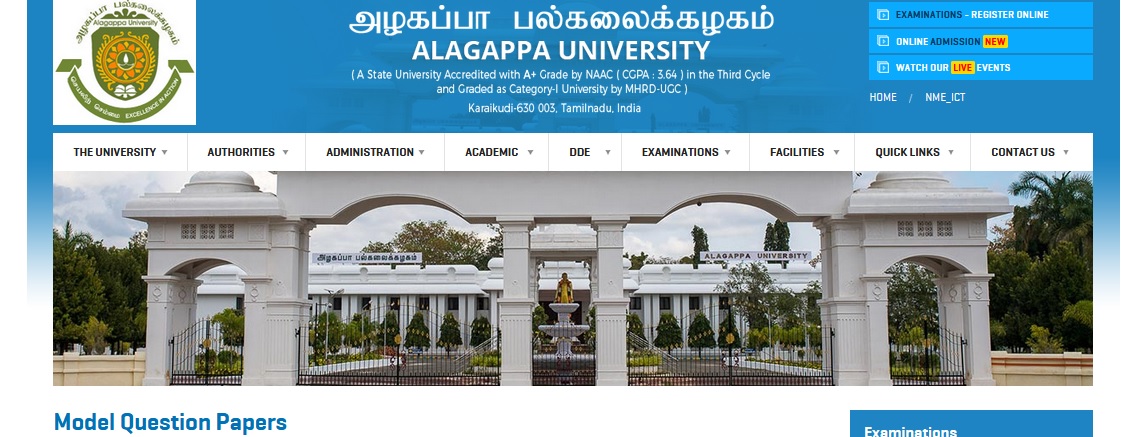Optical Fiber Communication Systems B.SC Model Question Papers : alagappauniversity.ac.in
Name of the University : Alagappa University
Degree : B.SC
Department : Electronics
Subject Code/Name : Optical Fiber Communication Systems
Year : II
Semester : IV
Document Type : Model Question Papers
Website : alagappauniversity.ac.in
TNMGRMU Optical Fiber Systems Question Paper
Part – A
(10 × 2 = 20) :
1. Define Numerical apprture.
2. State Snell’s law of reflection.
Related : Production And Maintenance Management B.Sc Model Question Papers : www.pdfquestion.in/4258.html
3. Mention the various types of semiconductors.
4. Give the principles of LASER.
5. What are the various optical couplers used in communication system-
6. Name the various optical detectors.
7. Mention the wavelength range of LED transmitter.
8. What is the use of high impedence pre amplifier –
9. What are the advantages of star topology –
10. What is a point link system –

11a. Compare Graded Index and Step Index Optical Fibers.
12a. What are the properties of a hetro junction –
13a. Explain the functions of optical isolators.
14a. Draw the block diagram of Analog LASER transmitter and explain
15a. Explain wavelength Division Multiplexing.
16. Explain in detail about various Attenuation mechanisms in optical
17. Discuss the role of PIN photodiode, in optical receiver.
18. Discuss the principle and operation of various connectors used in
19. Draw the flowchart for optical fiber transmitter design and explain it.
20. Short notes on :a) Bus topologiesb) Ring topologies
Part – B
(10 × 2 = 20) :
Answer ALL Questions
1. What is a depletion region-
2. When does an avalanche breakdown occur-
3. What is meant by loadline for a transistor-
4. Mention the use of voltage divider network.
5. On what criterion the amplifiers are classified-
2 AF-1583
6. Distinguish between a Voltage feedback amplifier and a Current
7. State Barkhausen criterion.
8. Draw the tank circuit part of Hartley oscillator.
9. Expand MOSFET and JFET.
10. What is meant by Ohmic region-
11. a. Study the characteristics of a PN junction diode in forward bias.
12. a. How does a transistor work-
13. a. Draw the circuit diagram of a push – pull amplifier and explain the
14. a. How oscillations are produced using crystals-
15. a. Write down the important features of an enhancement
16. With a neat circuit diagram, explain the working of a zener voltage
17. Study the input and output characteristics of an NPN transistor in
18. Discuss the working of a multistage RC coupled amplifiers.
19. Analyze the action of a Wein bridge oscillator.
20. Describe the action of common source FET amplifier.
Part – C
(10 × 2 = 20)
Answer All questions
1. What are complements-
2. Write down the rules of Karnaugh map.
3. Give the principle of magnitude comparator.
4. What is meant by decoding-
5. What is flip – flop-
6. Draw the block diagram of an ADC.
7. Mention the advantage of diode – transistor logic.
8. What is a CMOS logic family-
9. State the principle of magnetic core memory.
10.Which type of memory is more useful-
11. a. Explain subtraction of two numbers using 1’s complement with
12.a. Draw the circuit diagrams of half and full adders.
13.a. With a circuit diagram, explain the action of a RS flip-flop.
14.a. Discuss the working of a DTL circuit.
15. a. Write on RAM cells developed using MOSFETs.
16. Describe the conversion process of decimal numbers into
17. Discuss the function of a multiplexer with its function table.
18. Elaborate the working of R – 2R ladder type DAC.
19. Express the importance of ECL.
20. Give details about PLDs, PROMs and CD – ROMs.
My subject code is 1BELE1B